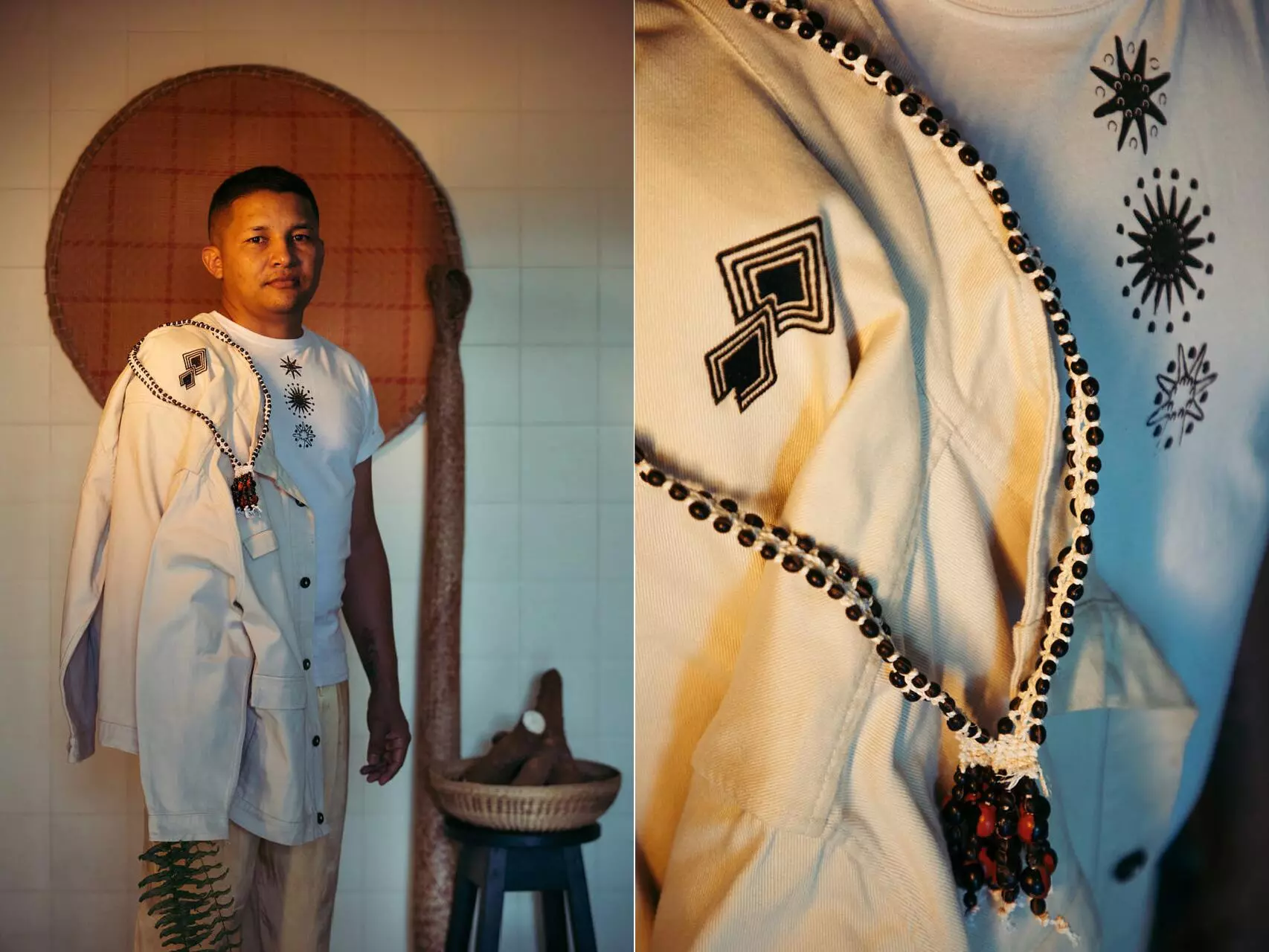December 2022 was already almost halfway through when Sioduhi packed his new creations, research materials and fabrics into a suitcase in his home and workshop, in Parque Savoy City, in the west of São Paulo. The fashion designer from the Pira-tapuya people was preparing for a journey that would reconnect him with his indigenous origins. The light luggage that accompanied him to Rio Branco, in the state of Acre, contrasted with the weighty achievements of the last four years, when he became a professional designer, fulfilling a childhood dream that took him to the outer suburbs of São Paulo, the South American capital of fashion. Sioduhi was leaving to desembolhar – in other words, to “unbubble” himself from life in the city.
Deciding to live in the Amazon again didn’t seem to make a lot of sense at a time when Sioduhi had finally started to establish himself as a designer, to stage shows and take his label Sioduhi Studio on a journey through the competitive world of São Paulo fashion, frequenting events, signing contracts and involving more and more people in his projects.
But the realization had come in October when Sioduhi, who hadn’t been back to the Amazon for twelve years, spent 25 days in his people’s territory on the upper River Negro, in the São Gabriel da Cachoeira region, in the state of Amazonas. Born in Mariwá, in the Middle Uaupés area, he grew up in the small town of Lauaretê. On the visit to his origins, he realized he had been “bubbled” – a word he invented for the experience of being uprooted and forgetting his own reality – in São Paulo. “It was a real battle, I had almost left my roots behind. I’m leaving [São Paulo] at the right time,” he says.
The Pira-tapuya child who spoke Tukano and harvested maniva (ground manioc leaves) and other root vegetables in the fields with his mother; who fished for piraíba and surubim (species of catfish) with his father, felt, aged 27, the burden of having “crossed worlds”. The boy who spent the summer on the beach by the river, caught freshwater shrimp with his brothers, played in the mud with his cousins and paddled his canoe, had moved to a concrete jungle, far from the center of the city and the catwalks, where he had to be born again.
“It was all a very difficult experience. I left one place for another where nobody eats the same food or speaks the same language as me, nobody is like me at all, and then was badly treated precisely for that reason. I was forced to speak Portuguese, forced to act in certain ways, and had to go to a speech therapist. Crossing these two worlds is really complex and delicate, because we’re tortured by the western world,” he says.
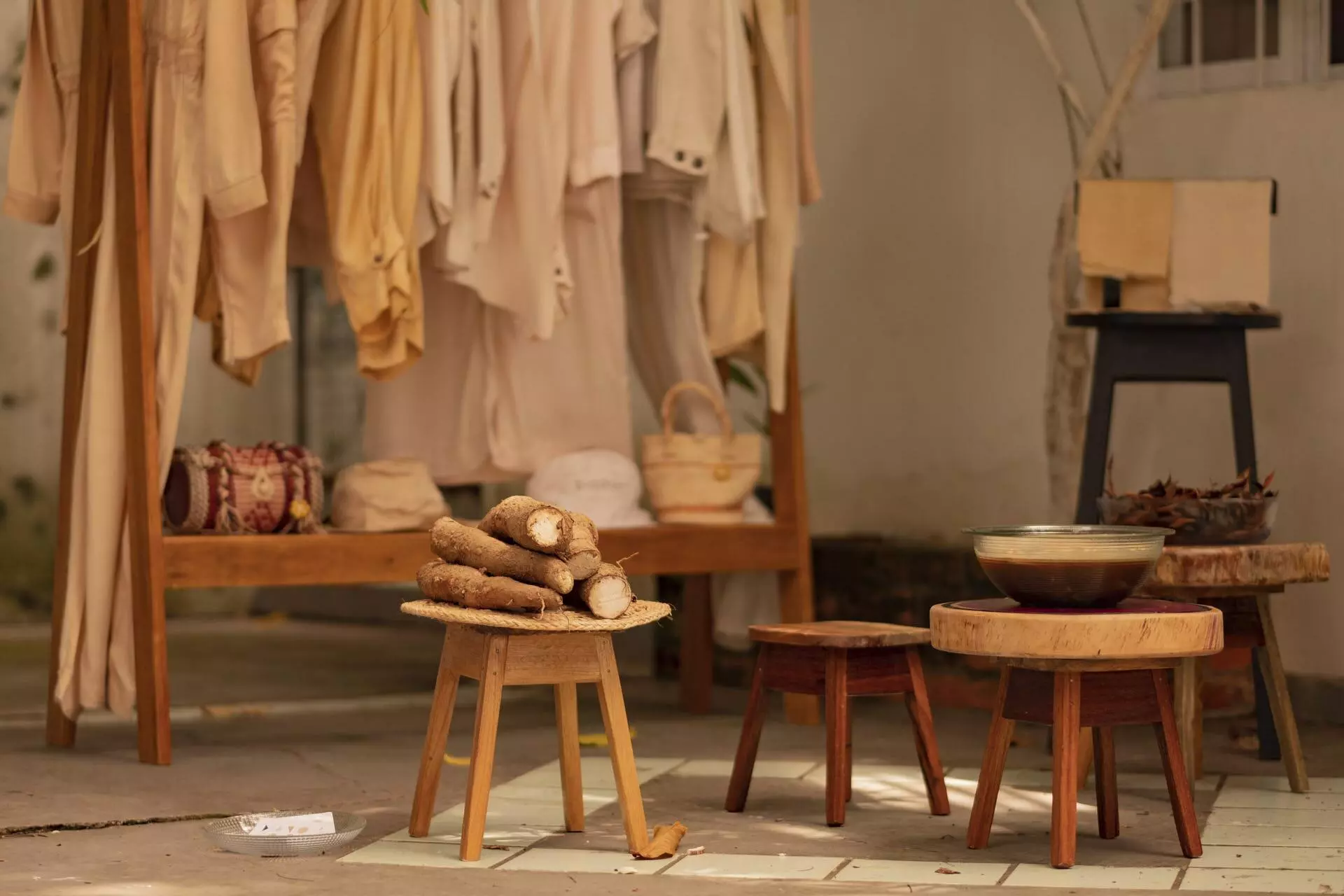
Sioduhi’s atelier in Rio Branco, in the state of Acre. Photo Alexandre Cruz-Noronha/SUMAÚMA
It is a violent journey, for someone who has experienced prejudice since the age of twelve, when he left his indigenous territory to go to school in São Gabriel da Cachoeira. “I didn’t think it was prejudice. I thought it was normal for people to treat me badly. I didn’t know who I was and I didn’t know how to defend myself,” says Sioduhi, who only understood part of these processes through counselling sessions at a mental health care service for indigenous peoples at the University of São Paulo. He lost count of how many times he was humiliated for being indigenous. In São Paulo, he realized that people didn’t understand his creations, and underwent six months of speech therapy. That’s when he discovered that his voice lacked undulations, because the Tukano language, phonetically speaking, is “horizontal”, while Portuguese is “oval”.
He also realized he was only accepted when he entered the “bubble”. “You look better today because you’re dressed like a white man,” was one of the supposed compliments he was given in a toxic fashion environment. All of a sudden, Sioduhi felt he was losing his identity in order to meet stereotypical expectations. “I am often expected to create something very traditional, something very cartoonish or obvious, and I don’t like obvious things, because at the core I want to create something that goes beyond that.”
It was this perceived prejudice that made him give up using an “integration name” – when indigenous people assume easy-to-understand identities in urban areas – and keep his original name. Sioduhi means “grandson of the one who sings while seated”, the one who carries the spirit of the ancestral baiá, the musician from the ancient ceremonies of the Upper Rio Negro. It is no coincidence that the designer wears a reinterpretation of the necklace worn by the baiá, an artist like himself, around his neck. His people, the Pira-tapuya, are “fish-people”, and are represented in the logo of his label, as well as in other references to the forest that appear in his designs in a variety of forms, and in the paints extracted from the earth, such as manioc.
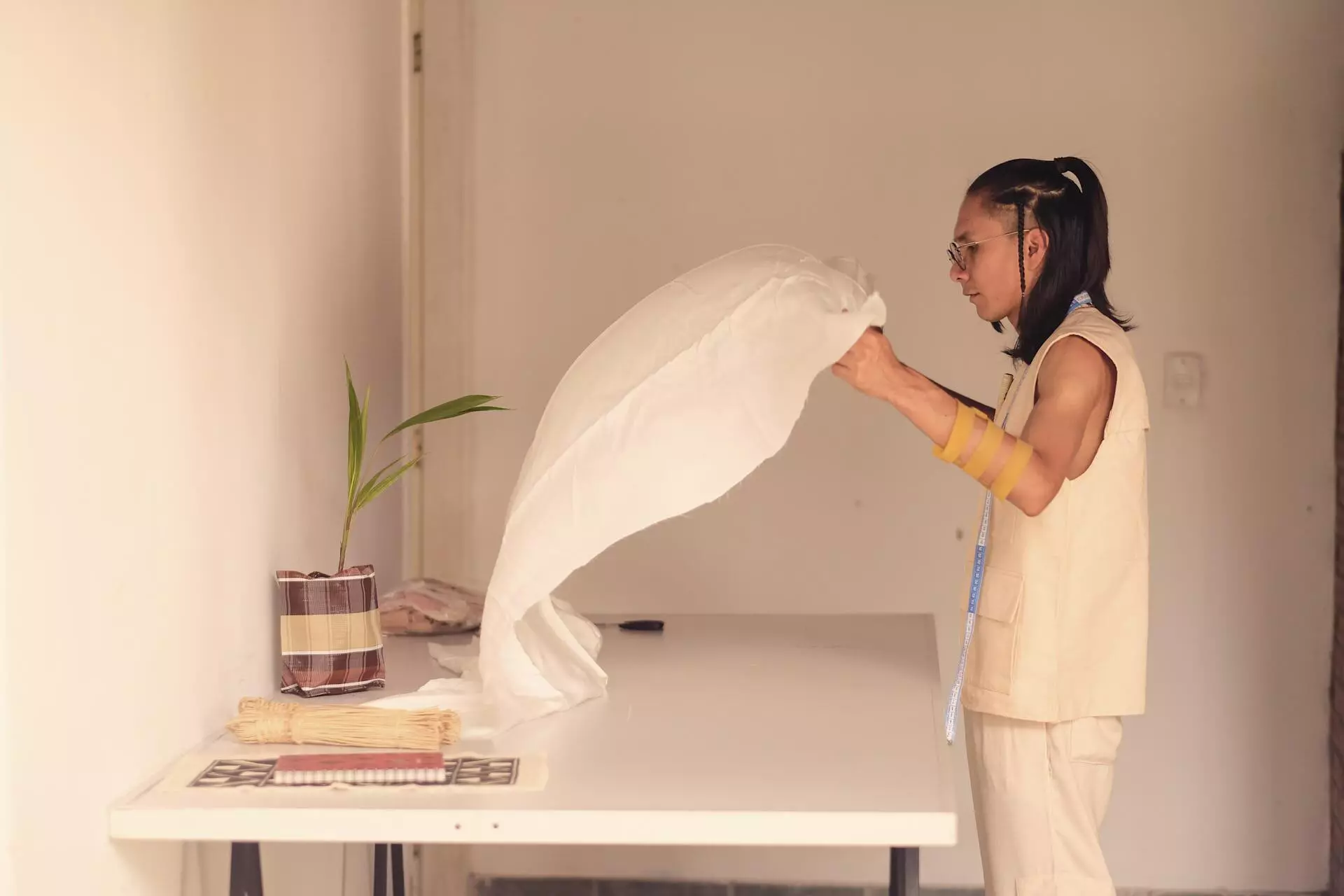
Designing clothes was a childhood dream. Photo: Alexandre Cruz-Noronha/SUMAÚMA
In the short period spent in São Paulo, Sioduhi found himself being constantly challenged and learned everything he would need to make the journey back home. He studied garment modeling at the State Technical School, Etec Tiquatira, and completed an MBA in Project Management at the Getúlio Vargas Foundation. At his Sioduhi Studio, he became an organized and versatile entrepreneur, doing everything from the delicate, imperceptible stitching of tailoring to the modern, sophisticated company website, which he created himself.
“I managed to master the Portuguese language, and non-indigenous information technology. This means we’re indigenous, and we’re powerful and intelligent too. When we look at it from the other direction, the non-indigenous can barely understand, connect with or mold themselves to our world, so we have a great advantage. It’s an intelligence and a freedom that many people don’t want to see,” reflects the artist with regard to the prejudice he suffered as an intellectual. “We know their world, but they don’t know our world, and they don’t make an effort to know it.” According to Sioduhi, this is also true in the world of the catwalks, which never look beyond the south and southeast of Brazil.
“Many of us indigenous artists are self-taught. Hardly any of us went to a well-known school. [If we are] In art class we get taught about Van Gogh, Picasso, Tarsila [do Amaral, a Brazilian modernist painter], and not [indigenous illustrator] Feliciano Lana (1937-2020), one of the figures who greatly inspired me with his vision and skill at telling stories. When will [Lana’s] work be taught in schools? This is my indigenous concern,” he asks, about the world of white people who don’t want to see his world.
Sioduhi wants to take what he has learnt with him to help create spaces for indigenous and Amazonian fashion. “What do Elle, Vogue, Glamour know, to be able to talk about us? To them we’re all Tupi. It is difficult to talk about the indigenous agenda, and they’ll never accept that they don’t know. People want to talk about the Amazon, but they don’t want to move there,” he says, thinking of ways to pierce the “bubbles”, to escape the silent and fatal erasure of his culture.
“Let’s talk about the Amazon the right way, let’s be protagonists. If we aren’t accepted by the fashion magazines, let’s make one. If we aren’t accepted into the fashion schools, let’s create our own. It’s one thing to be complaining and another thing is to turn that into action, even if it’s by experimenting,” says Sioduhi. He is one of the founders of the Abya Yala Criativa (Abya Yala Creative) fashion platform, in partnership with Jeremias, from the Akroá-Gamella people of the state of Maranhão, and Nath, a transvestite from Mato Grosso do Sul, both architecture students at the State University of Campinas.
Thinking outside the bubble
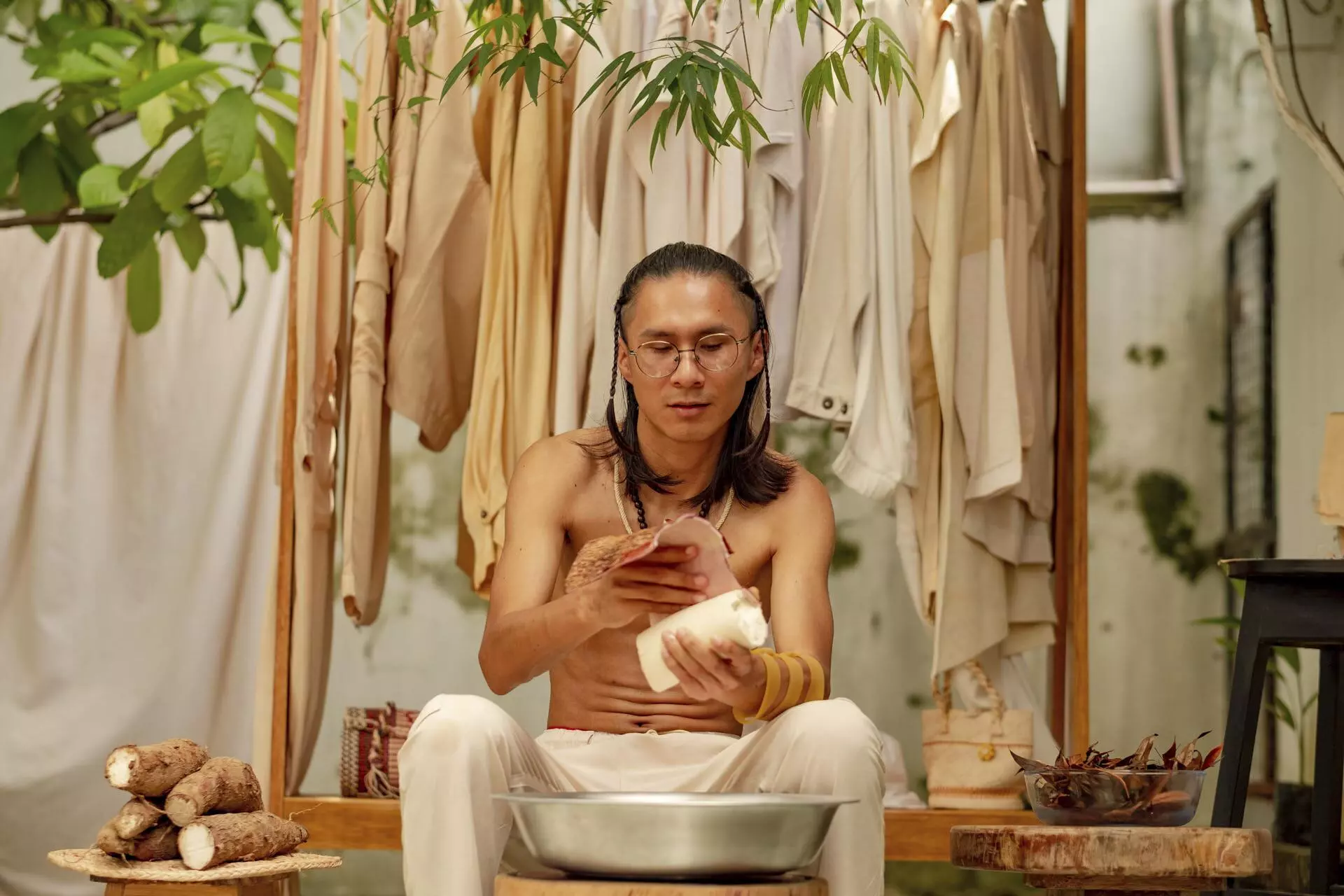
Sioduhi created a natural dye made from manioc, which he named Maniocolor. Photo Alexandre Cruz-Noronha/SUMAÚMA
Listening to and following Sioduhi’s reasoning is a gift. On his workbenches, there are sewing machines, scissors, threads, fabrics, paints and, next to them, lots of books. He proudly displays the Curso Pratico De Designer De Moda (Practical Fashion Designer Course, in English), a classic hardcover manual where he had his first contact with modeling, finishing and tailoring. But, in the corners of the atelier, which for the last four years has also been his home, there are texts on philosophy, the indigenous cosmovision, history, traditional agriculture and environmental management. Two volumes he shows me among many are Tybyra, uma Tragédia Indígena Brasileira (Tybyra, a Brazilian Indigenous Tragedy), by the Rio Grande do Norte artist Juão Nin, the story of the first LGBTQIA+ murdered by the Brazilian State, in the 17th century, and the Historia del Tahuantinsuyu, by the Peruvian archaeologist María Rostworowski. The Incas and the Tahuantinsuyu are on his list of connections between ancestral territorialities and the future, such as the concept of Abya Yala, which is an indigenous term for the continent that is used by those who want an alternative to the colonially-laden “Americas”. “They don’t expect us indigenous people to do research,” he says. “I study a great deal.”
Among the readings and references he frequently cites is “Indigenous Futurism”, a concept developed by the American scholar and anishinaabe Grace L. Dillon in 2003, to describe how indigenous peoples transmit their scientific teachings, honoring the past, living in the present and representing the future for the generations to come. Sioduhi knows how Dillon’s ideas intertwine with those of other scholars, such as the writer Jaime Diakara, of the Desana people, from whom he derives the concept of circular and spiral thinking of the indigenous peoples of the Upper Rio Negro, where the past, present and future take place simultaneously.
“From this circularity, various ways of thinking arise, a circular economy, an affective economy, ESG (Environmmental and Social Governance), a concern for sustainability, a concern for circular chains. All of this is the result of ancient knowledge that has often not been recognized”, he says.
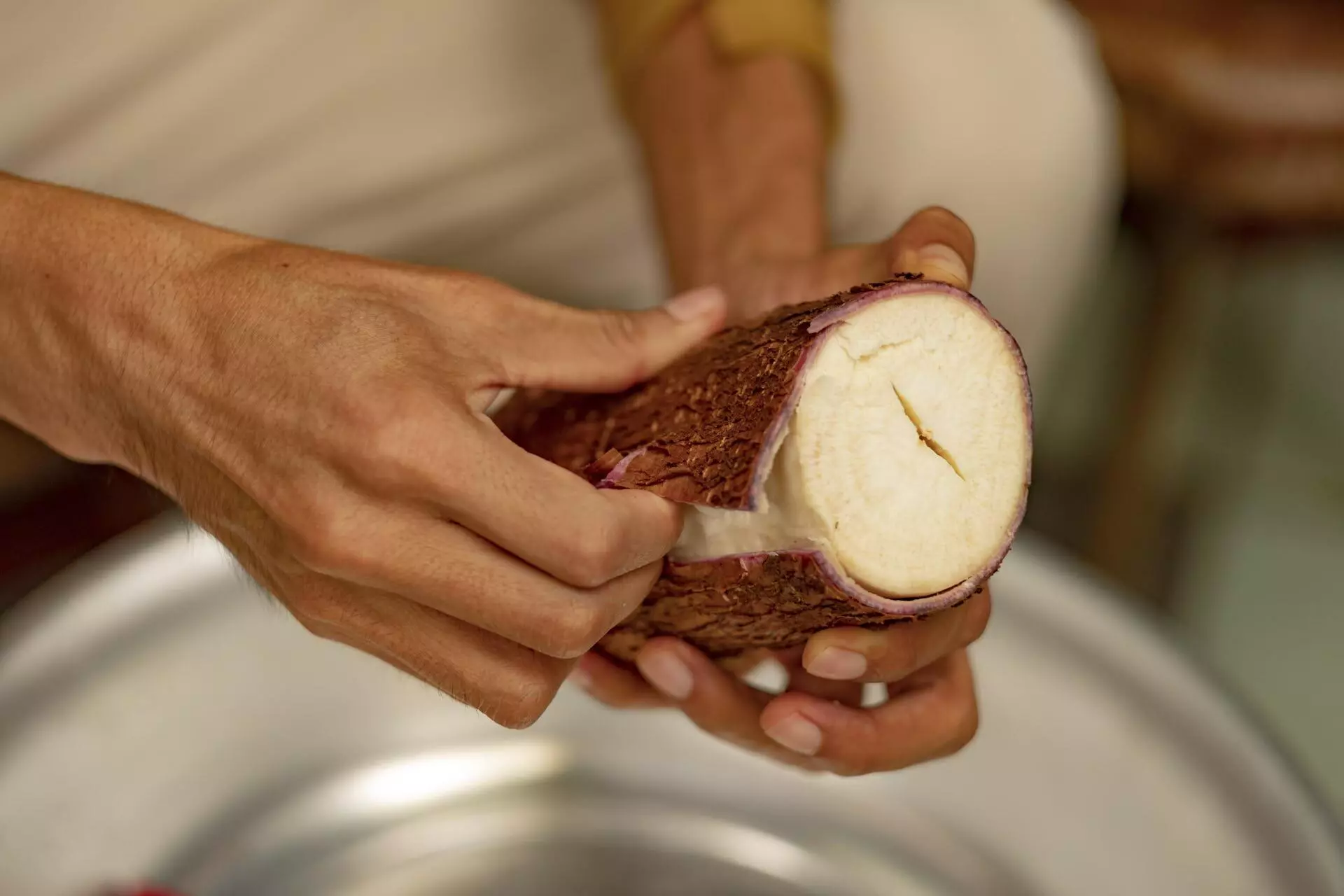
Maniocolor dye is made from manioc scrapings. Photo Alexandre Cruz-Noronha/SUMAÚMA
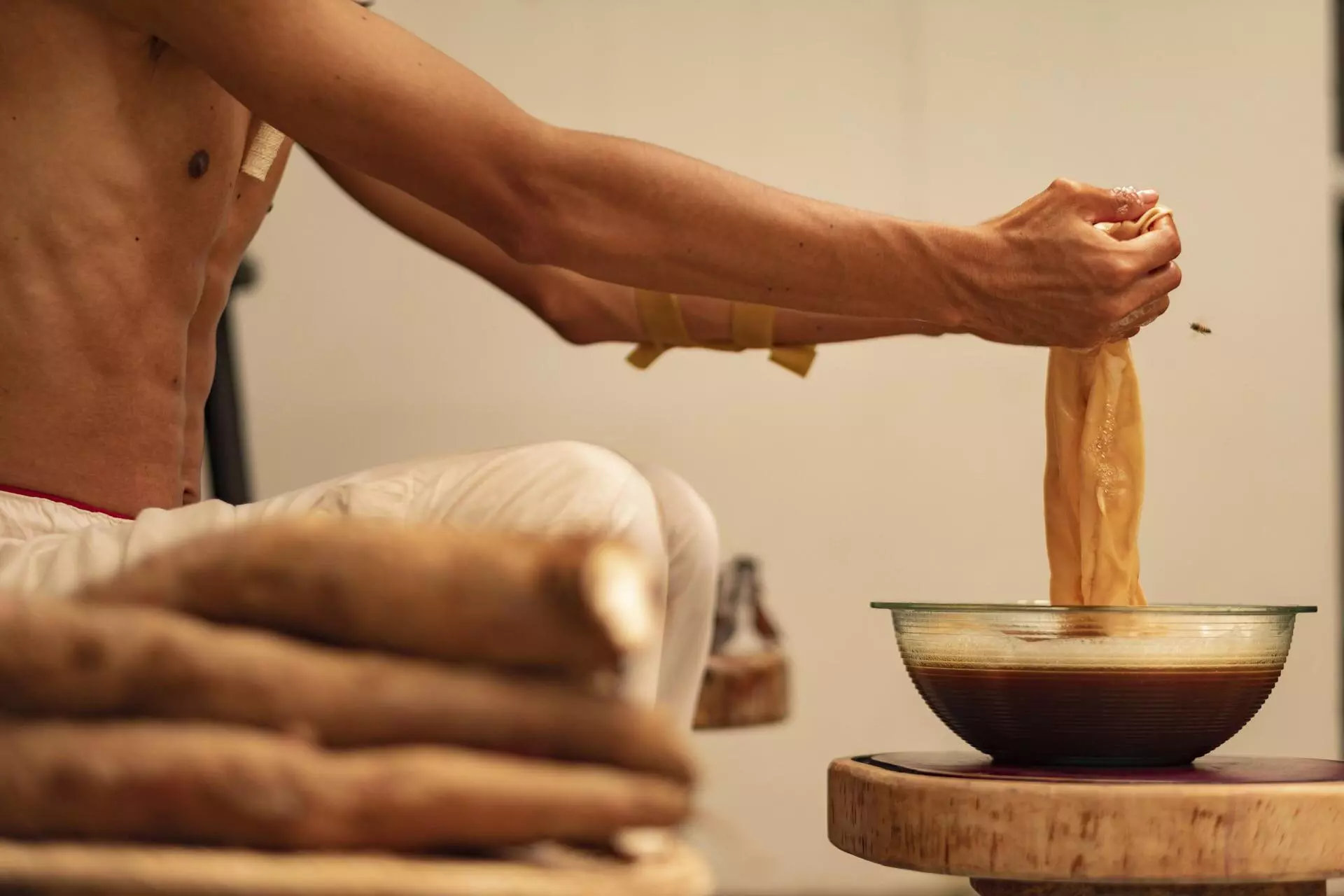
ManioQueen is a combination of the words manio (manioc in the Tupi language) and queen. Photo: Alexandre Cruz-Noronha/SUMAÚMA
In addition to reading, he also carries out research. Sioduhi spent a year studying a natural dye made from manioc scrapings, which he named Maniocolor. The project, developed with his business partner Adeilson Lopes, was finalized at the beginning of December, and was the result of a grant from the Nova Amazônia (New Amazon) acceleration program, promoted by Sebrae Nacional, and was also supported by the Rio Negro System of Traditional Agriculture.
In his reflections between one world and another, Sioduhi creates more than clothes and dyes, he uses words and concepts, and seeks ways to express himself and to understand himself and us. Embolhar (to find oneself isolated, as though in a bubble) and experenciar (to experience) are verbs that, for him, explain ideas of “passing through worlds” and “indigenous futurism”, but also things the West took centuries to understand, yet which are commonplace in his territory, such as sustainability and living well, diversity and welcoming.
In contrast to the disinterest he feels the fashion industry shows for those who work behind the scenes, Sioduhi operates in a network, with many other indigenous minds. “On the Upper Rio Negro there are 23 indigenous peoples who speak 18 languages. We live through tolerance, diversity, diplomacy,” he says – three characteristics he considers to be extremely important to his creative process.
“But my great realization is that every time I move to this [Western] world, I need to reconnect with my roots, and listen to my parents, who are already elders,” says the artist, who is returning to the forest to tell, through fashion, the invisible stories not written in books. He wants to leave the knowledge gained through his research for the next generations.
Sioduhi will only return to São Paulo to collect the books he couldn’t carry, and eventually for work and business. For now, his life once again circulates through the forest, between Rio Branco and São Gabriel da Cachoeira, where he will again move like the fish-people. Sioduhi will no longer find himself “bubbled”.
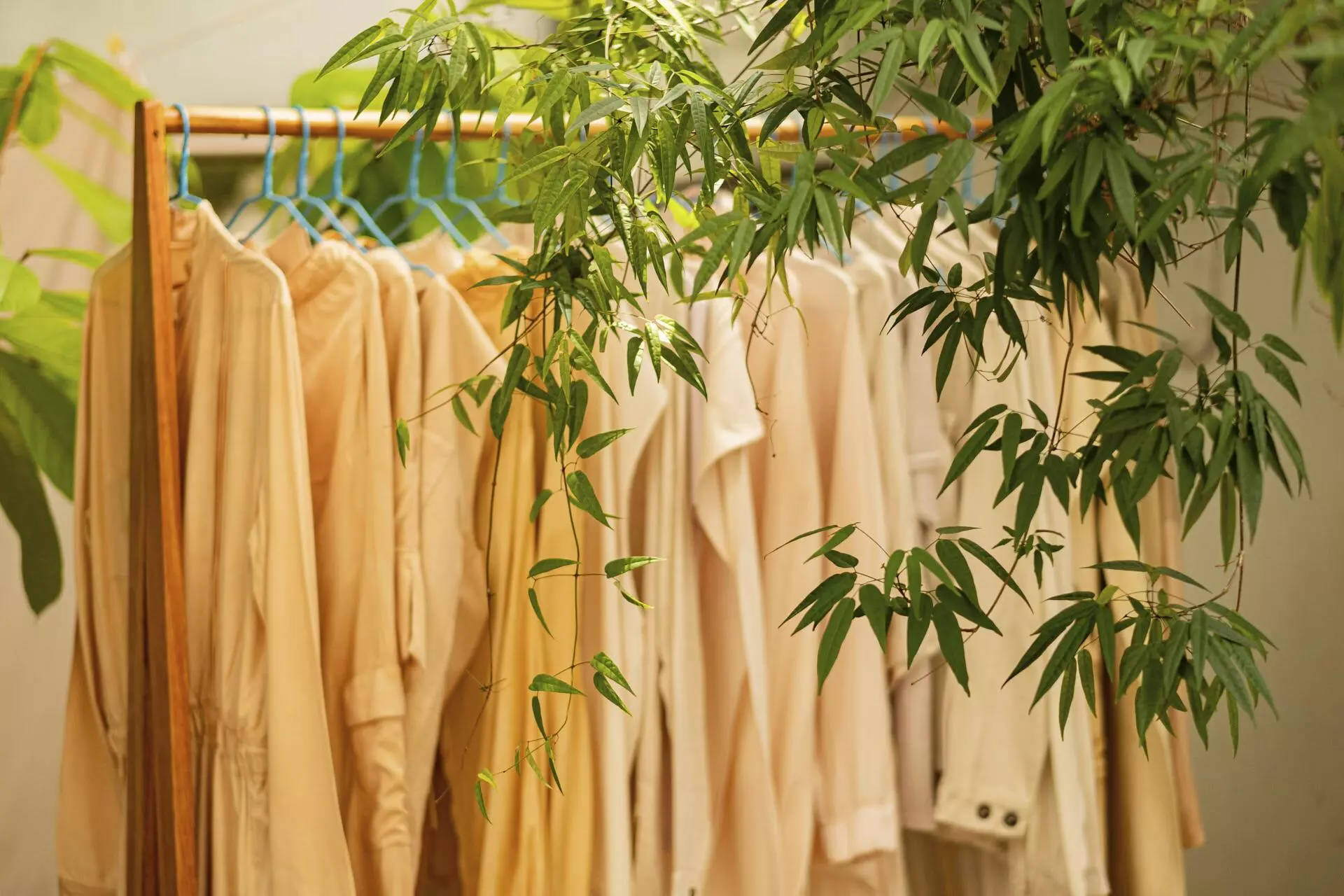
Items from the ManioQueen collection in Sioduhi Studio, in Rio Branco. Photo Alexandre Cruz-Noronha/SUMAÚMA
Sioduhi’s fashion
Amazonian designer Sioduhi proudly chose the pieces from his latest collection, ManioQueen, to dress the ribeirinho (a member of a traditional forest community) journalist Maickson Serrão, of the Tupinambá people, during his visit to the World Economic Forum, in Davos, Switzerland, this month.
“For me, it’s extremely important to make a contribution to someone who is raising important issues within the Amazon,” says the artist. “It’s the first time I’ve styled someone [meaning to design a complete “look”, including clothes and accessories]. We know how much we need our voices outside Brazil,” explains Sioduhi, who says he had a lot of fun during this new experience of working with the podcaster of the Pavulagem and Rádio Sumaúma programs.
Sioduhi’s color palette, highlighted in his creative process, reflects feelings and moments, and is based on his research into natural dyes. His Pamiri 23 collection, in 2021, was “more serious”, utilizing many shades of black and red to speak of the transformation and resistance of the 23 indigenous peoples of the upper Rio Negro.
In ManioQueen, which will make the journey to Davos with Maickson Serrão, pastel colors and a sense of lightness predominate. “It’s a way of talking about the indigenous struggle within territories, where many people need to be cheerful to face difficulties, because our rights are constantly being threatened, and government policies don’t reach the territories in the way they should,” he explains.
ManioQueen is a combination of the words manio (manioc in the Tupi language) and queen. It is a mixture of the feminine, of caring, and of the importance of indigenous food, the root that was discovered and incorporated into people’s diet thousands of years ago, and is also present on Brazilian lunch plates. “It’s a way of looking at it in a lighter way, kind of funny, and also very futuristic,” he says, about the research he did to develop the Maniocolor dye, but also about the thousand-year old indigenous biotechnology, which made manioc such an important cultural reference.
In the construction of his style, transparency, the accuracy of cutting and sewing, and his processes within his production chain are also notable. The brand employs up to thirty people during the period when the collection is put together, working in a network, and collectively. Sioduhi knows his needle-workers, and those who work behind the scenes of the fashion shows, in planning, campaign development and audiovisual production. He records everything. “I have a really good connection with them. The brand, as much as it carries my name, is a very collective place.”
In Sioduhi’s creative process, everything is cumulative, from the combination of different peoples, to the forms of knowledge and technology. Everything carries his essence, which will soon be seen, and known, in Davos.
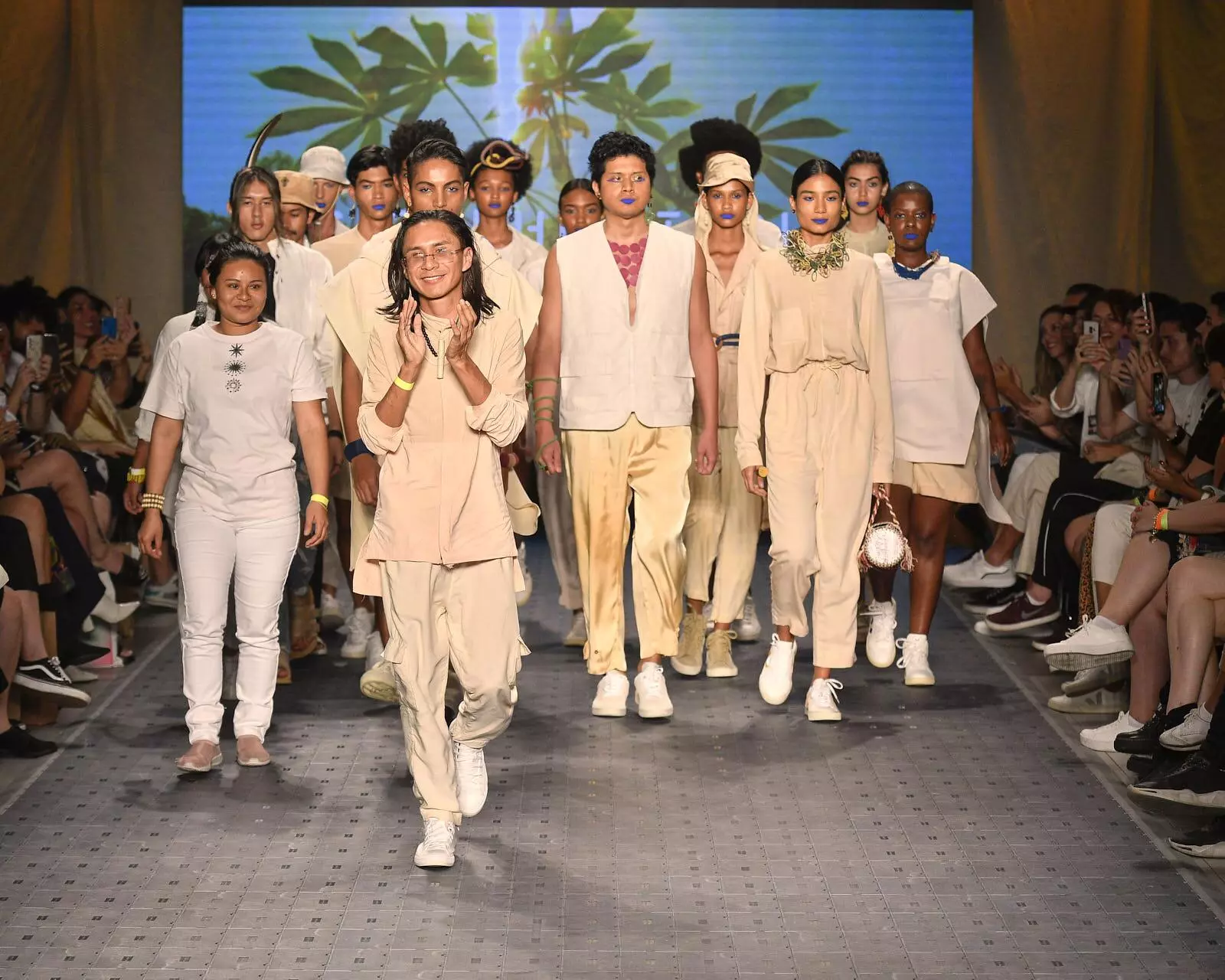
Sioduhi Studio show at the 6th Brasil Eco Fashion Week in São Paulo, in December 2022. Photo Marcelo Soubhia.
WHERE TO BUY SIODUHI STUDIO CLOTHES AND ACCESSORIES
ONLINE
Official Sioduhi store: sioduhi.com (deliveries only in Brazil)
SHOPS
MANAUS
GALERIA AMAZÔNICA
Rua Costa Azevedo, 272, Centro, Manaus (AM)
CEP: 69010-230, Brazil
WhatsApp: (92) 99221-9928
SÃO GABRIEL DA CACHOEIRA
INSTITUTO SOCIAMBIENTAL RIO NEGRO (TELECENTRO)
Rua Projetada, 70, Centro, São Gabriel da Cachoeira , AM
Tel: (97) 3471-1156
CUSCO (PERU)
EL PANAL — ETHICAL DESIGN
Plazoleta Santo Domingo, 285 – Cusco. PERU
Tel: +51 969 704 506
Translated by James Young




